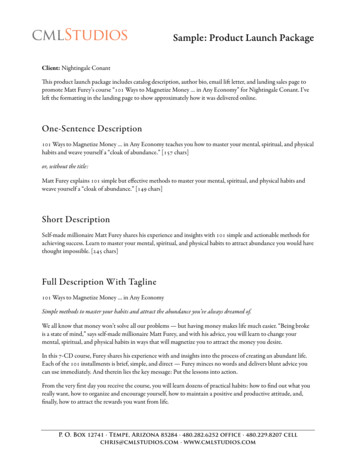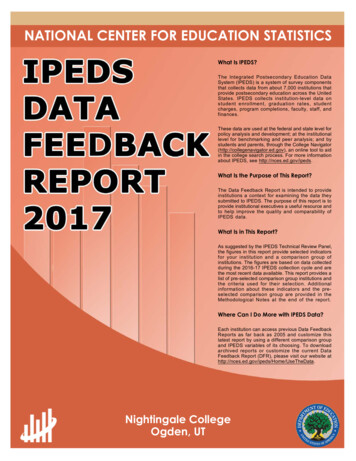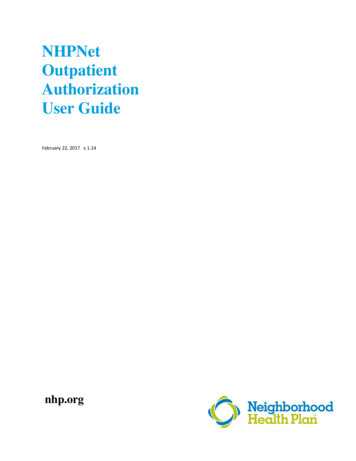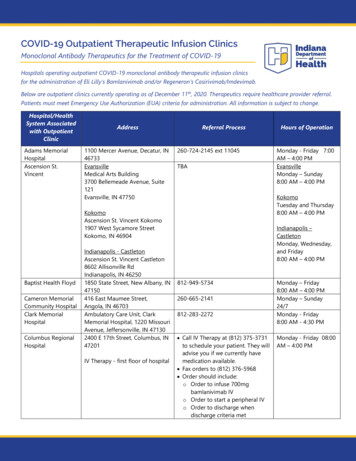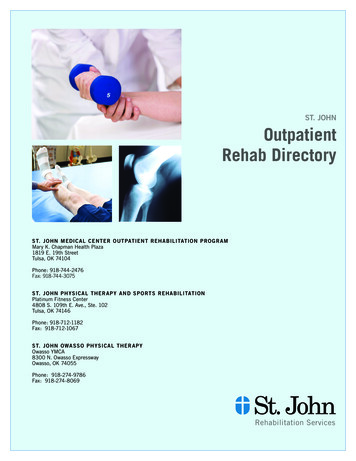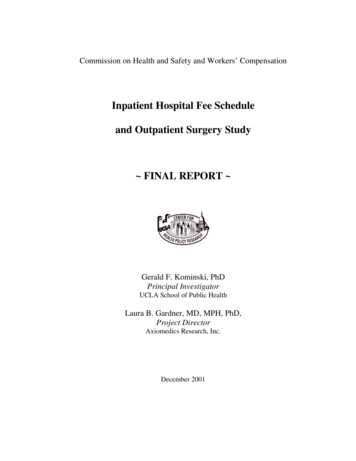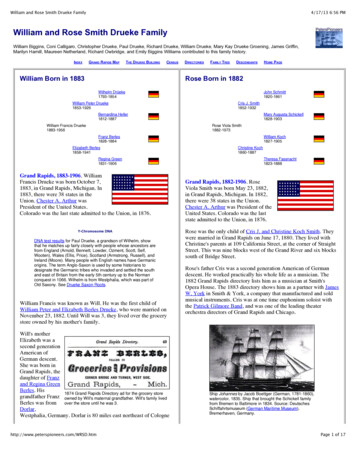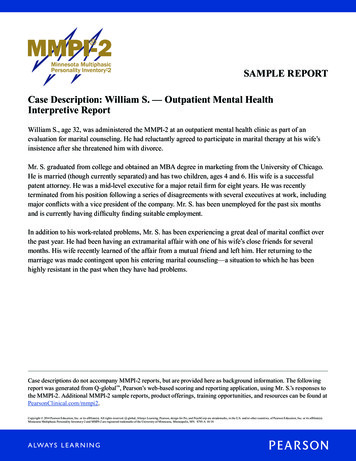
Transcription
SAMPLE REPORTCase Description: William S. — Outpatient Mental HealthInterpretive ReportWilliam S., age 32, was administered the MMPI-2 at an outpatient mental health clinic as part of anevaluation for marital counseling. He had reluctantly agreed to participate in marital therapy at his wife’sinsistence after she threatened him with divorce.Mr. S. graduated from college and obtained an MBA degree in marketing from the University of Chicago.He is married (though currently separated) and has two children, ages 4 and 6. His wife is a successfulpatent attorney. He was a mid-level executive for a major retail firm for eight years. He was recentlyterminated from his position following a series of disagreements with several executives at work, includingmajor conflicts with a vice president of the company. Mr. S. has been unemployed for the past six monthsand is currently having difficulty finding suitable employment.In addition to his work-related problems, Mr. S. has been experiencing a great deal of marital conflict overthe past year. He had been having an extramarital affair with one of his wife’s close friends for severalmonths. His wife recently learned of the affair from a mutual friend and left him. Her returning to themarriage was made contingent upon his entering marital counseling—a situation to which he has beenhighly resistant in the past when they have had problems.Case descriptions do not accompany MMPI-2 reports, but are provided here as background information. The followingreport was generated from Q-global , Pearson’s web-based scoring and reporting application, using Mr. S.’s responses tothe MMPI-2. Additional MMPI-2 sample reports, product offerings, training opportunities, and resources can be found atPearsonClinical.com/mmpi2.Copyright 2014 Pearson Education, Inc. or its affiliate(s). All rights reserved. Q-global, Always Learning, Pearson, design for Psi, and PsychCorp are atrademarks, in the U.S. and/or other countries, of Pearson Education, Inc. or its affiliate(s).Minnesota Multiphasic Personality Inventory-2 and MMPI-2 are registered trademarks of the University of Minnesota, Minneapolis, MN. 8795-A 01/14
Outpatient Mental Health Interpretive ReportMWilliam S.251132MaleSeparated181/31/14SAName:ID Number:Age:Gender:Marital Status:Years of Education:Date Assessed:PLEMMPI -2The Minnesota Report : Adult Clinical System-Revised, 4th EditionJames N. Butcher, PhDCopyright 1989, 1993, 2001, 2005 by the Regents of the University of Minnesota. All rights reserved.Portions reproduced from the MMPI-2 test booklet. Copyright 1942, 1943 (renewed 1970), 1989 by the Regents of the University ofMinnesota. All rights reserved. Portions excerpted from the MMPI-2 Manual for Administration, Scoring, and Interpretation, Revised Edition.Copyright 2001 by the Regents of the University of Minnesota. All rights reserved.Distributed exclusively under license from the University of Minnesota by NCS Pearson, Inc.Minnesota Multiphasic Personality Inventory and MMPI are registered trademarks and The Minnesota Report is a trademark of theUniversity of Minnesota. Pearson, the PSI logo, and PsychCorp are trademarks in the U.S. and/or other countries of Pearson Education,Inc., or its affiliate(s).TRADE SECRET INFORMATIONNot for release under HIPAA or other data disclosure laws that exempt trade secrets from disclosure.[ 9.5 / 1 / QG ]
ID: 2511William S.MMPI -2 Outpatient Mental Health Interpretive Report1/31/14, Page 2MMPI-2 VALIDITY 50404030VRINRaw Score:T Score:Response %:Cannot Say (Raw):Percent True:Percent 10010010010010010010002674Raw ScoreT ScoreResp. %S1 - Beliefs in Human Goodness1467100S2 - Serenity1064100S3 - Contentment with Life660100S4 - Patience/Denial of Irritability868100S5 - Denial of Moral Flaws458100
ID: 2511William S.MMPI -2 Outpatient Mental Health Interpretive Report1/31/14, Page 3MMPI-2 CLINICAL AND SUPPLEMENTARY SCALES PROFILE12012011011010010090E907050SA40HsRaw Score:7060M603080PL801K Correction:13T Score:54504030MAC-R 44105759694864Response %:100 100 100 100 100 100 100 100 100 100Welsh Code:4 68-3271/50:9# K' -/F:L#Profile Elevation:57.3AASPKHoMDS2133314451423242100 100 100 100 100 100
ID: 2511William S.MMPI -2 Outpatient Mental Health Interpretive Report1/31/14, Page 4MMPI-2 CONTENT SCALES PROFILE11011010010090E9070Raw Score:T Score:Response 5373935100 100 100 100 100 100 100 100 100 100SODFAM WRKTRT100 100 100 100 100
ID: 2511William S.MMPI -2 Outpatient Mental Health Interpretive Report1/31/14, Page 5PROFILE VALIDITYThis clinical profile has marginal validity because the client attempted to place himself in an overlypositive light by minimizing faults and denying psychological problems. This defensive stance ischaracteristic of individuals who are trying to maintain the appearance of adequacy and self-control.This client tends to deny problems and is not very introspective or insightful about his own behavior.EHis efforts to deny problems and present himself in a superlative manner might be understood moreclearly by looking at the type of content he endorsed in a defensive manner. He approached the testitems with a motivation to have others view him as a very well controlled person who never loses histemper or becomes irritated (as shown by his high score on S4, Patience or Denial of Irritability andAnger). In addition, he approached the test items with a desire to show that he has very positive views ofother people. He endorsed a number of items on the Beliefs in Human Goodness subscale.MSYMPTOMATIC PATTERNSPLThe clinical profile is likely to be an underestimate of the individual's psychological problems. He islikely to have little awareness of his difficulties. The client is likely to be rigid and inflexible in hisapproach to problems and may not be open to psychological self-evaluation. He is likely to project anexcessively positive self-image and to be somewhat arrogant and intolerant of others' failings. He isunlikely to seek psychological treatment or to cooperate fully with treatment if it is suggested to him.SAThe clinical scale prototype used in the development of this narrative included a prominent elevation onPd. The client is somewhat immature and impulsive, a risk-taker who may do things others do notapprove of just for the personal enjoyment of doing so. He is likely to be viewed as rebellious. He tendsto be generally oriented toward thrill seeking and self-gratification. He may occasionally show badjudgment and tends to be somewhat self-centered, pleasure-oriented, narcissistic, and manipulative. Heis not particularly anxious and shows no neurotic or psychotic symptoms.PROFILE FREQUENCYProfile interpretation can be greatly facilitated by examining the relative frequency of clinical scalepatterns in various settings. The client's high-point clinical scale score (Pd) occurred in 9.1% of theMMPI-2 normative sample of men. However, only 3.3% of the normative men had Pd as the peak scoreequal to or greater than a T score of 65, and only 1.9% had well-defined Pd spikes.The relative frequency of this profile in various outpatient settings is useful information for clinicalinterpretation. In the Pearson male outpatient sample, this was the most frequent high-point clinical scalescore (Pd), occurring in 17.8% of the sample. Additionally, 10.9% of the male outpatients had the Pdspike at or above a T score of 65, and 7.0% had well-defined Pd spikes.
ID: 2511William S.MMPI -2 Outpatient Mental Health Interpretive Report1/31/14, Page 6PROFILE STABILITYThe relative elevation of the highest scales in his clinical profile reflects high profile definition. Hishigh-point score on Pd is likely to remain stable over time. Short-term test-retest studies have shown acorrelation of 0.81 for this high-point score. Spiro, Butcher, Levenson, Aldwin, and Bosse (2000)reported a moderate test-retest stability index of 0.67 in a large study of normals over a five-yeartest-retest period.INTERPERSONAL RELATIONSEIndividuals with this profile pattern tend to be rather likable and personable and may make a good firstimpression. His tendency to take personal risks and to act out at times may make it somewhat difficult tomaintain close relationships.MPLQuite outgoing and sociable, he has a strong need to be around others. He is gregarious and enjoysattention. Personality characteristics related to social introversion-extraversion tend to be stable overtime. The client is typically outgoing, and his sociable behavior is not likely to change if he is retested ata later time. His personal relationships are likely to be somewhat superficial. He appears to be ratherspontaneous and expressive and may seek attention from others, especially to gain social recognition.DIAGNOSTIC CONSIDERATIONSSAThis pattern is consistent with those of individuals whose personality traits predispose them to problemsresulting from nonconformity.TREATMENT CONSIDERATIONSIndividuals with this profile are generally not self-referred for therapy because they typically feel thatthey have few problems. They may be seen in mental health assessment settings as a result of courtreferral or at the insistence of a family member. They are usually not very motivated to change theirbehavior and may leave treatment prematurely.Psychological treatment with this person may not be very successful because he tends to blame othersfor his problems.
ID: 2511William S.MMPI -2 Outpatient Mental Health Interpretive Report1/31/14, Page 7ADDITIONAL SCALESRaw ScoreT ScoreResp 1245667434855100100100100100Psychopathic Deviate SubscalesFamilial Discord (Pd1)Authority Problems (Pd2)Social Imperturbability (Pd3)Social Alienation (Pd4)Self-Alienation (Pd5)274415173515038100100100100100Paranoia SubscalesPersecutory Ideas (Pa1)Poignancy (Pa2)Naivete (Pa3)039405570100100100Personality Psychopathology Five (PSY-5) ScalesAggressiveness (AGGR)Psychoticism (PSYC)Disconstraint (DISC)Negative Emotionality/Neuroticism (NEGE)Introversion/Low Positive Emotionality (INTR)Supplementary ScalesMDepression SubscalesSubjective Depression (D1)Psychomotor Retardation (D2)Physical Malfunctioning (D3)Mental Dullness (D4)Brooding (D5)PLHarris-Lingoes SubscalesEAnxiety (A)Repression (R)Ego Strength (Es)Dominance (Do)Social Responsibility (Re)SAHysteria SubscalesDenial of Social Anxiety (Hy1)Need for Affection (Hy2)Lassitude-Malaise (Hy3)Somatic Complaints (Hy4)Inhibition of Aggression (Hy5)
ID: 2511William S.MMPI -2 Outpatient Mental Health Interpretive Report1/31/14, Page 8T ScoreResp %010101395042444046100100100100100100Hypomania SubscalesAmorality (Ma1)Psychomotor Acceleration (Ma2)Imperturbability (Ma3)Ego Inflation (Ma4)124142345337100100100100ERaw ScoreSchizophrenia SubscalesSocial Alienation (Sc1)Emotional Alienation (Sc2)Lack of Ego Mastery, Cognitive (Sc3)Lack of Ego Mastery, Conative (Sc4)Lack of Ego Mastery, Defective Inhibition (Sc5)Bizarre Sensory Experiences (Sc6)Social Introversion Subscales (Ben-Porath, Hostetler, Butcher, & Graham)421484538100100100044454100100Depression SubscalesLack of Drive (DEP1)Dysphoria (DEP2)Self-Depreciation (DEP3)Suicidal Ideation (DEP4)010140504162100100100100Health Concerns SubscalesGastrointestinal Symptoms (HEA1)Neurological Symptoms (HEA2)General Health Concerns (HEA3)021445448100100100Bizarre Mentation SubscalesPsychotic Symptomatology (BIZ1)Schizotypal Characteristics (BIZ2)004441100100Anger SubscalesExplosive Behavior (ANG1)Irritability (ANG2)003935100100Cynicism SubscalesMisanthropic Beliefs (CYN1)Interpersonal Suspiciousness (CYN2)113639100100PLShyness/Self-Consciousness (Si1)Social Avoidance (Si2)Alienation--Self and Others (Si3)Content Component Scales (Ben-Porath & Sherwood)SAMFears SubscalesGeneralized Fearfulness (FRS1)Multiple Fears (FRS2)
ID: 2511William S.MMPI -2 Outpatient Mental Health Interpretive Report1/31/14, Page 9T ScoreResp %133559100100Type A SubscalesImpatience (TPA1)Competitive Drive (TPA2)103933100100Low Self-Esteem SubscalesSelf-Doubt (LSE1)Submissiveness (LSE2)003941100100Social Discomfort SubscalesIntroversion (SOD1)Shyness e Treatment Indicators SubscalesLow Motivation (TRT1)Inability to Disclose (TRT2)PLFamily Problems SubscalesFamily Discord (FAM1)Familial Alienation (FAM2)ERaw ScoreAntisocial Practices SubscalesAntisocial Attitudes (ASP1)Antisocial Behavior (ASP2)SAUniform T scores are used for Hs, D, Hy, Pd, Pa, Pt, Sc, Ma, the content scales, the content componentscales, and the PSY-5 scales. The remaining scales and subscales use linear T scores.
MMPI -2 Outpatient Mental Health Interpretive Report1/31/14, Page 10ID: 2511William S.CRITICAL ITEMSThe following critical items have been found to have possible significance in analyzing a client'sproblem situation. Although these items may serve as a source of hypotheses for further investigation,caution should be used in interpreting individual items because they may have been checkedinadvertently.Acute Anxiety State (Koss-Butcher Critical Items)EThe percentages of endorsement for each critical item by various reference groups are presented inbrackets following the listing of the item. The endorsement percentage labeled "N" is the percentage ofthe MMPI-2 normative sample of 1,138 men who endorsed the item in the scored direction.Endorsement percentages for the normative sample are reported for all critical items. When available,endorsement percentages for the setting are also reported. The designation "Op" refers to a sample of10,510 male outpatients (Pearson, 1993).PLOf the 17 possible items in this section, 1 was endorsed in the scored directio
Psychological treatment with this person may not be very successful because he tends to blame others for his problems. MMPI -2 Outpatient Mental Health Interpretive Report ID: 2511 1/31/14, Page 6 William S. SAMPLE
